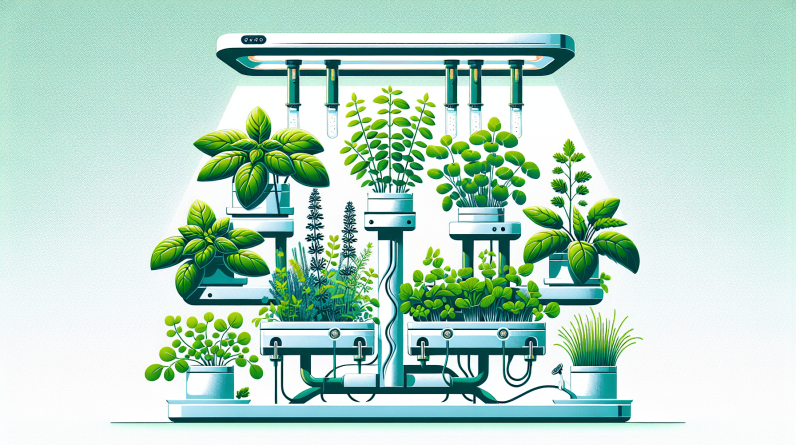
Have you ever considered Indoor Hydroponics for your gardening needs?
If you are looking for a new way to grow plants efficiently and sustainably, indoor hydroponics might be the perfect solution for you. This innovative method of cultivation eliminates the need for soil, conserves water, reduces the risk of pests and diseases, and allows year-round plant growth. Keep reading to learn more about why indoor hydroponics is gaining popularity among gardeners.
Understanding the Basics of Indoor Hydroponics
Indoor hydroponics is a method of growing plants without soil, using water-based nutrient solutions to feed the plants directly at their roots. This technique allows for faster plant growth, increased yields, and overall healthier plants. By providing essential nutrients directly to the plants in a controlled environment, indoor hydroponics offers a more efficient and sustainable approach to gardening.
Benefits of Indoor Hydroponics
One of the key advantages of indoor hydroponics is water conservation. Traditional soil gardening can be water-intensive, with a significant amount of water lost through evaporation and runoff. In contrast, hydroponic systems use water more efficiently, with some estimates suggesting they can reduce water usage by up to 90%. This makes indoor hydroponics a more environmentally friendly option for growing plants.
Another benefit of indoor hydroponics is the elimination of soil-borne diseases and pests. Without soil, plants are less susceptible to common issues such as root rot, nematodes, and fungal infections. This results in healthier plants that require fewer chemical inputs, making indoor hydroponics a safer and more sustainable choice for gardeners.
Year-Round Cultivation with Indoor Hydroponics
One of the most appealing aspects of indoor hydroponics is the ability to grow plants year-round, regardless of external weather conditions. By providing plants with a consistent environment indoors, gardeners can cultivate a wide variety of crops throughout the year. This is particularly advantageous for those living in regions with harsh winters or limited outdoor growing space.
Sustainable and Efficient Plant Growth
Indoor hydroponic systems are designed to be sustainable and efficient, using minimal resources to produce high-quality crops. By recycling and reusing water, nutrients, and energy, these systems can reduce waste and lower their environmental impact. Additionally, indoor hydroponics can be tailored to specific plant requirements, optimizing growth and productivity for each crop.
The Rise of Indoor Hydroponic Kits
As indoor hydroponics continues to gain popularity among gardeners, the market has seen an increase in the availability of hydroponic kits designed for home use. These kits typically include all the essential components needed to set up a hydroponic system, such as a reservoir, pump, growing medium, nutrient solution, and plant containers. They are easy to assemble and use, making indoor hydroponics accessible to beginners and experienced gardeners alike.
Key Features of Indoor Hydroponic Kits
Indoor hydroponic kits come in various sizes and configurations to suit different plant types and growing spaces. Some kits are compact and ideal for growing herbs, lettuce, or small vegetables on a countertop or windowsill. Others are larger and designed for cultivating larger plants like tomatoes, peppers, or cucumbers in a dedicated grow room.
Easy Setup and Maintenance
One of the main advantages of indoor hydroponic kits is their ease of setup and maintenance. Most kits come with detailed instructions that guide you through the process of assembling the system and setting up your plants. Once the system is up and running, maintenance typically involves monitoring water levels, nutrient concentrations, and pH levels to ensure optimal plant growth.
Customization Options
Many indoor hydroponic kits offer customization options to meet the specific needs of different plants. You can adjust the nutrient solution concentration, lighting intensity, and watering schedule to create the ideal growing conditions for your crops. This level of control allows you to experiment with different plant varieties and growing techniques, expanding your gardening skills and knowledge.

Choosing the Right Indoor Hydroponic System for Your Needs
When selecting an indoor hydroponic system, it’s essential to consider your specific gardening goals, available space, budget, and level of expertise. There are several types of indoor hydroponic systems available, each with its unique features and benefits. Understanding the differences between these systems will help you choose the one that best suits your needs.
DWC (Deep Water Culture) Systems
DWC systems are one of the most straightforward and popular types of indoor hydroponic systems. In a DWC system, plants are suspended in a nutrient solution with their roots submerged in oxygenated water. This method provides plants with a constant supply of nutrients and oxygen, promoting fast growth and high yields. DWC systems are easy to set up and maintain, making them ideal for beginners.
Ebb and Flow Systems
Ebb and flow, or flood and drain, systems use a pump to periodically flood the plant’s roots with nutrient solution before draining it back into a reservoir. This cycling of water provides plants with oxygen and nutrients, promoting healthy root growth and enhanced nutrient uptake. Ebb and flow systems are versatile and suitable for a wide range of plant sizes and types.
NFT (Nutrient Film Technique) Systems
NFT systems involve recirculating a thin film of nutrient solution over the plant roots, allowing for continuous nutrient delivery and oxygenation. This method promotes rapid plant growth and efficient nutrient absorption, making it ideal for growing leafy greens, herbs, and smaller vegetables. NFT systems are space-efficient and require minimal water and nutrient usage.

Tips for Successful Indoor Hydroponic Gardening
Whether you are new to indoor hydroponics or an experienced gardener looking to improve your skills, there are several tips and strategies you can use to maximize the success of your hydroponic garden. By following these guidelines, you can ensure healthy plant growth, abundant yields, and a rewarding indoor gardening experience.
Start with Easy-to-Grow Plants
If you are new to indoor hydroponics, consider starting with easy-to-grow plants like herbs, lettuce, or leafy greens. These crops are relatively low-maintenance and forgiving of beginner mistakes, making them ideal for learning the basics of hydroponic gardening. Once you gain confidence and experience, you can gradually expand to more challenging crops.
Monitor Water Quality and pH Levels
Maintaining proper water quality and pH levels is crucial for the success of your indoor hydroponic garden. Test your water regularly and adjust the pH as needed to ensure that your plants can absorb nutrients effectively. Poor water quality or imbalanced pH levels can lead to nutrient deficiencies, stunted growth, and overall plant health issues.
Provide Adequate Lighting
Light is an essential factor in plant growth, especially in indoor hydroponic systems where natural sunlight may be limited. Choose the right type of grow lights for your plants, ensuring they receive the proper amount of light for photosynthesis. LED grow lights are a popular choice for indoor hydroponics due to their energy efficiency, long lifespan, and customizable light spectrum.
Maintain Proper Nutrient Levels
In indoor hydroponic systems, plants rely on nutrient solutions to fulfill their essential nutrient requirements. Monitor nutrient levels in your reservoir regularly and adjust the solution according to your plants’ growth stage. Providing the right balance of nutrients will help your plants thrive, producing healthy foliage, flowers, and fruits.
Prevent and Manage Pests
While indoor hydroponic systems are less susceptible to pests than traditional soil gardens, it is essential to remain vigilant and proactive in pest management. Inspect your plants regularly for signs of pests or diseases, and take immediate action to prevent their spread. Using organic pest control methods or beneficial insects can help keep your hydroponic garden healthy and pest-free.

Conclusion
Indoor hydroponics is rapidly gaining popularity among gardeners worldwide, offering a sustainable, efficient, and rewarding way to grow plants without soil. By eliminating many of the challenges associated with traditional gardening, indoor hydroponics provides a versatile and customizable option for cultivating a wide variety of crops year-round. Whether you are a beginner or experienced gardener, indoor hydroponics can help you achieve your gardening goals and enjoy the benefits of fresh, healthy produce right at home. So why not give indoor hydroponics a try and see the difference it can make in your gardening experience?
Related Content
- The Hidden Benefits of Hydroponic Nutrients Revealed
- The Ultimate Guide to 2025 Hydroponic Herb Garden Strategies for Fresh Flavors
- The Ultimate Guide to Hydroponic Garden Maintenance: 10 Effective Tips for 2025
- Benefits of Hydroponic Growing Systems
- The Ultimate Guide to ebb and flow hydroponics: 7 Effective Strategies for 2025






